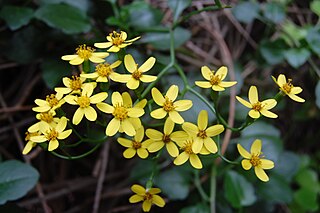
Senecio vulgaris, often known by the common names groundsel and old-man-in-the-spring, is a flowering plant in the daisy family Asteraceae. It is an annual herb, native to Europe and widely naturalised as a ruderal species in suitable disturbed habitats worldwide.

Custard apple is a common name for a fruit, and the tree which bears it, Annona reticulata.

Ampelopsis, commonly known as peppervine or porcelainberry, is a genus of climbing shrubs, in the grape family Vitaceae. The name is derived from the Ancient Greek: ἅμπελος (ampelos), which means "vine". The genus was named in 1803. It is disjunctly distributed in eastern Asia and eastern North America extending to Mexico. Ampelopsis is primarily found in mountainous regions in temperate zones with some species in montane forests at mid-altitudes in subtropical to tropical regions. Ampelopsis glandulosa is a popular garden plant and an invasive weed.

Delairea is a plant genus within the family Asteraceae. It is classified within tribe Senecioneae. It contains only one species, Delairea odorata, which was previously included in the genus Senecio as Senecio mikanioides, and is known as Cape ivy in some parts of the world and German ivy in others.

Packera glabella is one of several plants with the common name butterweed, this one has also been called cressleaf groundsel and yellowtop. It is native to central and southeastern North America.
Chamissoa altissima is native to North and South America. In Brazil it grows in the Cerrado vegetation. In Mexico it is called Hierba del arloma.

Senecio tamoides or also known as Canary creeper is a climbing member of the genus Senecio of the family Asteraceae.

Helianthus microcephalus is a perennial species of Helianthus also known as small woodland sunflower or small-wood sunflower or small-head sunflower or simply as woodland sunflower. It is a native of Northern America, and is to be found growing in open woodlands.

Roldana petasitis also known as velvet groundsel is a species of the genus Roldana and family Asteraceae that used to be a Senecio.

Senecio crassissimus is a species of the genus Senecio, family Asteraceae and endemic to Madagascar.

Senecio madagascariensis also known as Madagascar ragwort is a species of the genus Senecio and family Asteraceae. Other common names include Madagascar groundsel and fireweed. It has been included on the noxious weeds list for Hawaii and the reject list for Australia.

Senecio triangularis, known as arrowleaf ragwort, arrowleaf groundsel and arrowleaf butterweed, is a species of the genus Senecio and family Asteraceae.

Senecio planiflorus is a species of the genus Senecio and family Asteraceae. It is endemic to Chile.
Funastrum clausum, commonly known as white twinevine, is a species of flowering plant in the dogbane family, Apocynaceae. It is native to southern Florida and Texas in the United States, Mexico, the Caribbean, Central America, and South America as far south as Paraguay.

Aframomum corrorima is a species in the ginger family, Zingiberaceae. The spice, known as Ethiopian cardamom, false cardamom, or korarima, is obtained from the plant's seeds, and is extensively used in Ethiopian and Eritrean cuisine. It is an ingredient in berbere, mitmita, awaze, and other spice mixtures, and is also used to flavor coffee. In Ethiopian herbal medicine, the seeds are used as a tonic, carminative, and laxative.

Wedelia acapulcensis, commonly known as Acapulco wedelia, is a species of flowering plant in the sunflower family, Asteraceae. It is native to Texas in the United States, Mexico, and Central America.
Several species of plants are known by the common name umbrella grass or umbrella-grass, including:















